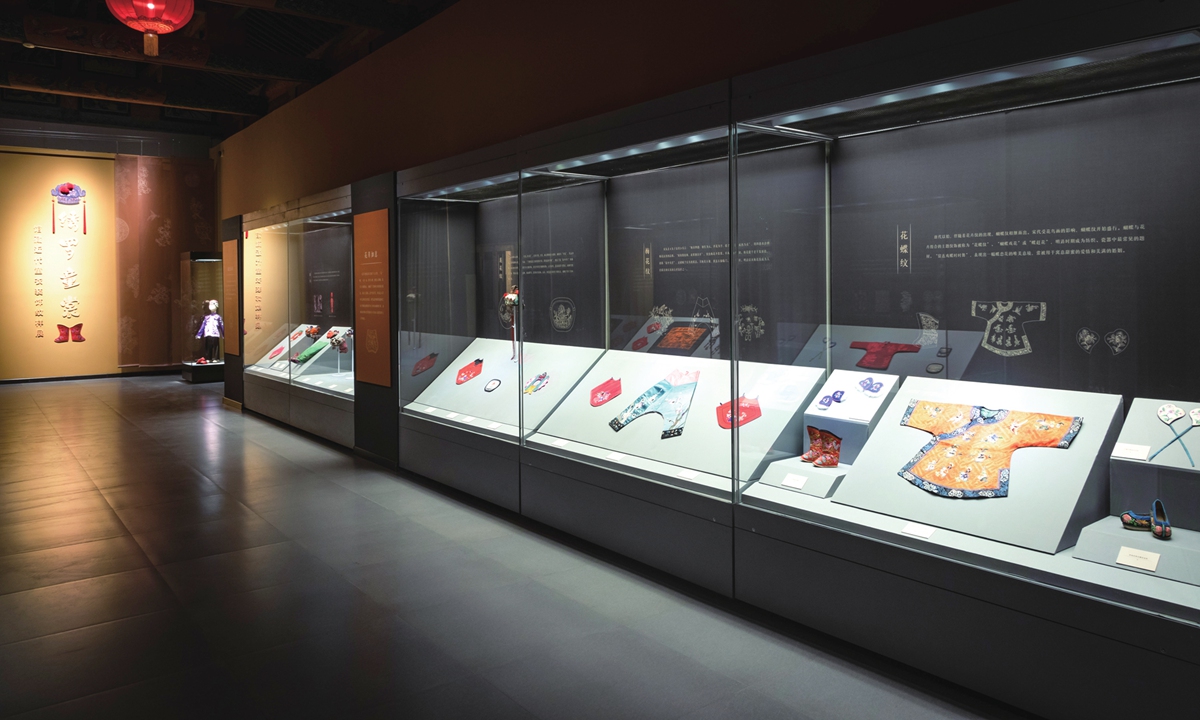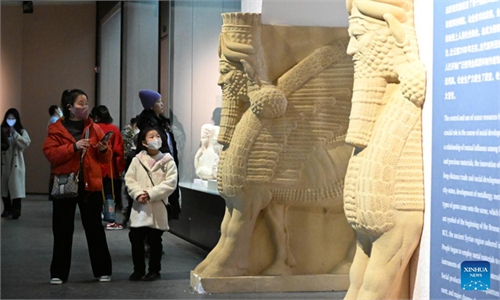With love and hope
New exhibition on children’s clothing sheds light on ancient wisdom and craftsmanship

The children's wear exhibit at the Shanxi Archaeology Museum in Taiyuan, North China's Shanxi Province Photos: Courtesy of the Shanxi Archaeology Museum

The children's wear exhibit at the Shanxi Archaeology Museum in Taiyuan, North China's Shanxi Province Photos: Courtesy of the Shanxi Archaeology Museum
Zhang Ke is expecting a second baby. The exquisiteness of the children's clothing in their collection inspired Zhang, a collection manager at the Shanxi Archaeology Museum in Taiyuan, North China's Shanxi Province, to do more.
"Every time I looked at the intricate embroidered clothes in the collection, an impulse grew in me that made me want to learn more about their history," Zhang told the Global Times as she curated an exhibition focusing on modern Chinese children's wear.
"I have a kid and I am expecting a second. That also motivated me to develop an exhibition with these children's clothing."
Diverse in color and design, a total of 45 items of Chinese children's wear from the late Qing Dynasty (1840-1912) to the Republic of China period (1912-49), ranging from hats, dresses to shoes, are currently on display at the exhibition, which runs until June 30.
"Originally I just wanted to have a normal exhibition about children's wear, but after learning the stories behind the items in the collection, the motivation for the exhibition began to grow," Zhang told the Global Times.
In ancient China, children's clothing was often made by mothers and grandmothers, who embedded their maternal love and hopes in every embroidered stitch.
The items in the collection are categorized by the motifs decorating them: animals, plants and Chinese gods, all of which underline the good wishes of adults for their children.
Auspicious beasts
Tigers and lions are often seen on children's clothing such as hats, Chinese bellybands and pouches as these animals were seen as invincible natural creates that brought good fortune.
Pictures of these wild animals are often used to "disperse devils" and keep them from kids in a period when medical care was insufficient in ancient China, offering some hope, though often false, for a child's healthy life.
However, "poisonous" animals were also seen on children's wear during the period. Snakes, scorpions, spiders, centipedes and toads are often called the Five Poisons in ancient Chinese culture.
To help kids overcome these "poisons," these animals' motifs were used as supporting designs to decorate children's wear as a bid to suppress them.
Plants are another often-seen symbol decorating children's wear in ancient China, as they were seen to bring hope. A combination of flowers and birds were most widely used.
A royal blue Chinese jacket hangs at the entrance of the exhibition hall.
It features four different kinds of flower motifs stitched on its front. The flowers, Magnolia denudata, pomegranate flower, chrysanthemum and Narcissus, represent the four seasons: spring, summer, autumn and winter.
The backside of the jacket, however, features three other different plants: Buddha's hand, pomegranates and peaches. These collectively symbolize good luck, long life and prosperous descendants in Chinese culture.
Peony flowers were also a favorite for expressing people's wishes for the future, thus making them an essential element in decorating children's wear.
Stories about gods
Taoism is deeply rooted in China as the household deities in China originated from Taoism sagas, such as the young Nezha, who is often considered a protector of children.
"Making these historical sagas and auspicious symbols into embroidered designs expressed wishes for good luck, thus were popular on children's wear," Zhang said.
The qilin, a legendary dragon-like auspicious creature, is also a favorite design appearing on children's wear, as it represents a prosper life with many kids in Chinese symbology.
The curator also noted that the way the collection is organized also gives visitors insight into the mindset of parents.
"The survival of a child, who faces potential diseases, is the most vital thing for parents, thus choosing an auspicious animal as a protector becomes a priority," Zhang told the Global Times.
"Staying alive makes everything possible. Parents want a prosperous life for their kids and descendants, that's why we see plants and deities embroidered on children's wear."
The exhibition has attracted plenty of children.
"Visiting children have shown strong interest in the intricate nature of the embroidery on the clothing," Zhang said, adding that elder visitors, mostly those over 70, have noted the items on exhibition are very similar to what they wore as children.
"As a museum worker, it is our duty and mission to reach out to the public and make our collections come alive," Zhang said.

